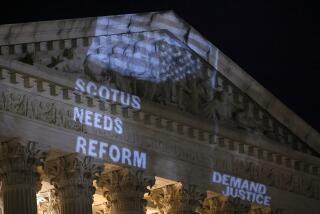Q&A: The century-old filibuster may end. Here’s why it matters
WASHINGTON — If Democrats win control of the Senate and White House in November, many progressives want to get rid of a long-standing Senate rule — the legislative filibuster — to ensure that their agenda in a Joe Biden presidency isn’t foiled by Republicans’ obstructions.
That would allow legislation to pass with 50 votes instead of the 60 required in recent decades for any significant initiatives. Whether to abolish or scale back the filibuster is one of the most consequential decisions Democrats would make, affecting the prospects for bills on healthcare, climate change, guns, immigration and more.
Proponents say the filibuster has been grossly misused, undermining the Senate’s effectiveness, and they believe Republicans would use it to block anything Biden tried to achieve. But critics in both parties warn that ending the filibuster would damage the Senate as an institution, and allow the majority to steamroll the other party.
What is the filibuster, and why does it matter?
The filibuster is a political blockade by a united minority to prevent a Senate vote on a bill. In recent decades, when the minority party won’t relent in its opposition, the majority must hold a so-called cloture vote — requiring a supermajority of 60 votes — to break the blockade and permit the Senate to act on the pending legislation.
Ideally for the minority party, if the majority can’t muster 60 votes, either it must compromise with the minority or its legislation dies.
Why do progressive Democrats want to get rid of the filibuster now?
If Democrats win a majority, they will almost certainly have fewer than 60 votes. Presumably Senate Majority Leader Mitch McConnell (R-Ky.) — if he wins reelection — would become the minority leader and instruct Republicans to filibuster any progressive legislation that comes before the Senate, much like he did as minority leader in President Obama’s first six years.
“We don’t think Mitch McConnell should be allowed to weaponize partisan obstruction … to prevent any opportunity to make the changes that the American people want,” said Eli Zupnick, spokesman for Fix Our Senate, a coalition of progressive groups advocating to eliminate the filibuster.
Among their Senate allies is Sen. Jeff Merkley (D-Ore.). “I’m holding conversations with [senators] saying, ‘Are we going to have a functioning legislative body or not?’” he said.
Will Senate Democrats actually end the filibuster?
That’s unclear. But an increasing number of Democrats have become supportive.
Sen. Jon Tester (D-Mont.) wants to keep the filibuster, but acknowledged that moderates like him could change their minds if Republicans use it to block a Democratic majority’s legislation.
“I didn’t come here just to watch somebody stonewall,” he said. “If it’s like the economy is going to hell and we’re not doing anything to help, that’s not healthy.”
Given the hesitance of those like Tester, few expect Democrats — if they’re the majority — to have enough votes to change the rules when the new Senate convenes in January. More likely, momentum would build if Republicans repeatedly filibuster.
Democratic leaders, including Sens. Richard J. Durbin of Illinois and Patty Murray of Washington, have voiced more support in recent days. Murray said in a statement that she’d prefer bipartisanship, but “I also know we’ve got a long list of challenges that grow more urgent by the day. And I’m not interested in watching Sen. McConnell or Senate Republicans keep us from acting if we have the chance.”
The top Democrat in the Senate, Sen. Charles E. Schumer of New York, has not ruled out the idea, nor has Biden. In the first presidential debate Tuesday, Biden sidestepped the issue: “Whatever position I take on that, that’ll become the issue.”
While Biden, a longtime senator before he was vice president, is considered an institutionalist who favors Senate tradition and bipartisanship, he also doesn’t want his agenda to be dead on arrival in the Senate.
Democrats’ anti-filibuster momentum already may be building, given their outrage at Senate Republicans’ power play to confirm a successor to Justice Ruth Bader Ginsburg — Amy Coney Barrett — even as voting has begun for the next president. Senate Republicans in 2016 blocked President Obama’s nominee after Justice Antonin Scalia died nine months before the election.
“If the Senate Republicans confirm Judge Barrett, Democrats must move to end the filibuster and expand the Court in the next Congress,” Sen. Edward J. Markey (D-Mass.) said.
Why keep the filibuster?
Proponents, including Sen. Dianne Feinstein (D-Calif.), say eliminating it would only deepen the polarization in Washington. The 60-vote requirement is supposed to encourage the majority to reach consensus with the minority on bills, though that’s increasingly rare.
The filibuster “really does require some level of bipartisanship. It requires some negotiation,” Sen. Angus King (I-Maine) said in 2018. “The majority can’t just run over the minority, and in the long run, legislation is better if it’s formed that way.”
Richard Arenberg, a former Senate Democratic aide who co-wrote “Defending the Filibuster: Soul of the Senate” in 2012, warned that without the filibuster, legislation could be enacted and then undone again as control of Congress and the White House changed hands.
“The legislative filibuster may be the single most important thing preserving the Senate’s constitutional role as a check on majority tyranny,” Sen. John Thune of South Dakota, a Republican leader, said recently.
What might Democrats do?
They could completely eliminate the filibuster. But options that stop short of that are viewed as more likely.
Merkley has proposed requiring a more active filibuster. Senators would have to be in the chamber to lodge their opposition or have to keep talking, alone or in tandem with allies. Either method would likely reduce the number of filibusters.
Absent the filibuster, could Democrats pass Medicare for All and the Green New Deal?
That’s unlikely, at least in the short term. Democrats would still need 51 votes, and neither program is thought to have that much support even if the party has additional members in next year’s Senate.
How did the filibuster come to be?
The Constitution says the Senate makes its own rules. In 1805, shortly after then-Vice President Aaron Burr killed Alexander Hamilton, he persuaded the Senate to get rid of its rule for cutting off debate. But according to Sarah A. Binder, a senior fellow at the Brookings Institution, that opened the door to the filibuster in the mid-1800s — with opposing senators talking nonstop to prevent a vote on bills.
In 1917, the Senate acted to curb the practice. The result was a precursor of the filibuster rule as it exists today: The Senate could end debate by a vote of two-third of all senators. The threshold was later reduced to three-fifths, or 60 votes.
For a half-century after 1917, filibusters were few; the Senate cast votes to end them no more than seven times in each two-year Congress, according to congressional statistics. Over time, however, they gradually increased and then spiked as politics became more polarized in recent decades.
The Senate over the last two years has set a new record: 258 votes to end filibusters. Yet even that doesn’t convey the impact of the obstructionist tactic: If the majority leader knows 41 senators would support a filibuster, he typically has shelved a bill because of the difficulty of corralling 60 votes.
Hasn’t the filibuster been scaled back already?
Yes. Amid Republicans’ obstruction of Obama’s appointees, in 2013 Democrats got rid of the filibuster for executive branch nominees and all judges except Supreme Court justices. Just four years later, Republicans got rid of the filibuster for Supreme Court justices, to confirm President Trump’s first nominee, Neil M. Gorsuch, 54-45.
Obama said the filibuster is a relic of Jim Crow times. True?
In his eulogy of civil rights icon Rep. John Lewis in July, Obama urged the Senate to eliminate the filibuster — calling it “another Jim Crow relic” — so the Senate could pass a new voting rights bill. While Obama overstated the connection — the filibuster has been used against many policies and nominees — history does show a link.
Southern Democrats for decades used the filibuster — or just the threat of one — to oppose Civil Rights-era bills, including anti-lynching legislation going back to the 1920s. In the mid-50s, Vice President Richard M. Nixon — acting as the president of the Senate — led an unsuccessful effort to repeal the filibuster to allow passage of a voting rights bill, according to Adam Jentleson, a former aide to Senate Majority Leader Harry Reid (D-Nev.) and author of the forthcoming book “Kill Switch: The Rise of the Modern Senate and the Crippling of American Democracy.” Perhaps the most famous filibuster was Sen. Strom Thurmond’s 24-hour, 18-minute talkathon against a Civil Rights bill in 1957.
More to Read
Get the L.A. Times Politics newsletter
Deeply reported insights into legislation, politics and policy from Sacramento, Washington and beyond. In your inbox three times per week.
You may occasionally receive promotional content from the Los Angeles Times.











